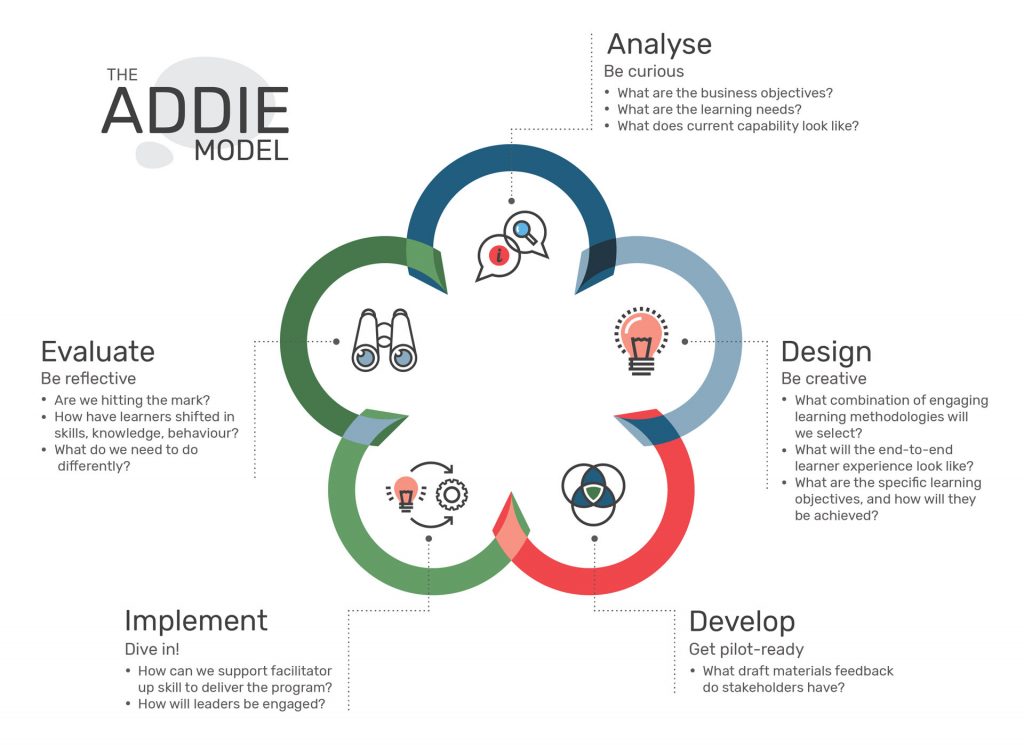Instructional Design Course Outline
Instructional Design Course Outline
What should the instructional design course outline include?
Instructional design includes assessing learning needs, designing the learning process, creating rich learning experiences, developing learning materials and evaluating the effectiveness of a program or training development course.
This is achieved by drawing on principles of andragogy (how adults learn), instructional design principles and methods of instructional design, such as the ADDIE Model).
What are the stages of instructional design?
Most Instructional Designers apply the ADDIE Model of Instructional Design to design and develop learning programs.
The ADDIE Model consists of five stages:
- Analyse
- Design
- Develop
- Implement
- Evaluate
Analyse
In the Analyse phase, Instructional Designers communicate with stakeholder, SMEs, target audiences and other relevant persons to gain insights.
Instructional Designers complete a Learning Needs Analysis (LNA) (also known as a Training Needs Analysis (TNA)) to determine the learning needs. This includes the knowledge, skills, behaviours and attitudes to achieve the desired outcome.
Once the learning needs have been identified, Instructional Designers recommend a combination of solutions and learning materials to be designed and developed. This recommendation is then presented to stakeholders for approval.
Design
In the Design phase, Instructional Designers structure the learning experience to determine an appropriate learning journey. They determine the duration, flow, learning outcomes, learning activities, delivery methods, resources, key content and concepts, assessment tools and program evaluation strategies.
The program design often includes pre-work activities (including reflection questions) and post work to support learning transfer. Embedding may also consists of a ‘Leader Kit’ – a suite of activities to be delivered by a Team Leader.
Develop
Instructional Designers develop the learning materials, which generally consist of facilitator guides/session plans, participant workbooks, PowerPoints, handouts, job aids/Quick Reference Guide (QRGs) and assessment tools.
They may also be required to draft video scripts, storyboards for eLearning or images for graphic designers to create for any specific eLearning instructional design course.
In the Design phase, evaluation tools are also produced. These may include participant questionnaires (pre, 30 days post, 90 days post), focus group sessions and observation checklists for leader to complete.
Implement
This is when the program comes to life! Instructional Designers deliver a ‘Train the Trainer’ session to prepare facilitators for program delivery.
This provides a chance for the Instructional Designer to up skill trainers on the program, ensure they understand the content, concepts and delivery methods, and opportunity for the facilitator to ask any questions before pilot.
Evaluate
Instructional Designers review information gathered from the evaluation tools to review the effectiveness of the learning program and materials.
To learn more about the ADDIE Model and how to apply it, complete one of our Instructional Design Courses.
What should be included in a course outline?
Course outlines should include:
- Course description: What is the course about?
- Duration: How long in the course?
- Course objectives: What is the course aiming to achieve?
- Learning outcomes: What will participants learn?
- Structure and delivery methods: Wow will they learn it?
- Assessment methods: What will they be assessed on and how?
- Pre-requisites: What qualifications do participants need to begin the course?
- Outcomes: What will participants get out of it? What opportunities will this course present? What qualifications will participants achieve on successful completion?
What are the four instructional design models?
Four common instructional design models include:
- The ADDIE Model
- Merrill’s Principles of Instruction
- Bloom’s Taxonomy
- Gagne’s Nine Events of Instruction
The Addie Model
The ADDIE Model provides a process for designing and developing learning programs. ADDIE stands for Analyse, Design, Develop, Implement and Evaluate.
Merrill’s First Principles of Instruction
In developing the First Principles of Instruction, Merrill researched a wide range of instructional design theories and models and collated the commonalities to produce a set of instructional design principles.
Instructional Designers draw on these principles to produce learning experiences that reflect best practice.
Bloom’s Taxonomy
Boom’s Taxonomy is a framework that defines six levels of cognitive learning; Knowledge, Comprehension, Application, Analysis, Synthesis and Evaluation.
This framework is used by Instructional Designers to create effective learning objectives and to design activities that build higher-order thinking.
Gagne’s Nine Events of Instruction
Gagne’s Nine Events of Instruction provides a nine-step process that Instructional Designers use to structure their learning sessions.
The following nine events are intended to be carried out sequentially to support the learning process:
- Gain the attention of the students.
- Inform the learner of the objective.
- Stimulate recall of prior learning.
- Present the content.
- Provide learning guidance.
- Elicit the performance.
- Provide feedback.
- Assess the performance.
- Enhance retention and transfer.



